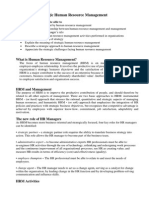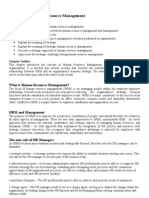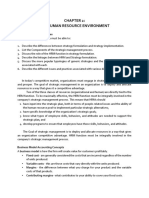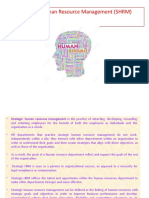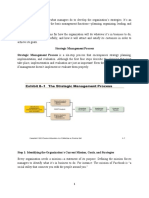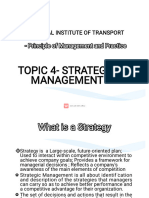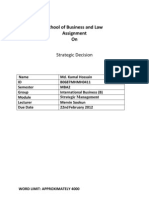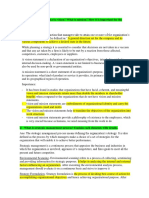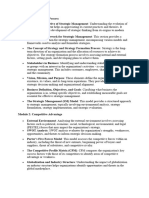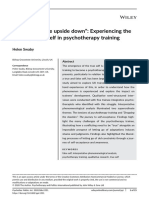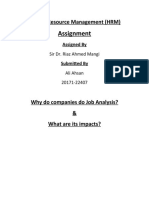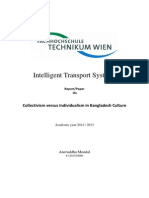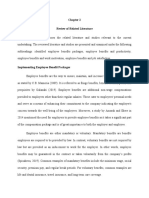Class 1
Class 1
Uploaded by
Rozibul BasarCopyright:
Available Formats
Class 1
Class 1
Uploaded by
Rozibul BasarOriginal Description:
Original Title
Copyright
Available Formats
Share this document
Did you find this document useful?
Is this content inappropriate?
Copyright:
Available Formats
Class 1
Class 1
Uploaded by
Rozibul BasarCopyright:
Available Formats
Class: 01, MBA for BBA
Strategic HRM
Introduction
Required Skills of Manager
Technical Skills: Specially important for Ist line manager
Interpersonal Skills: The ability to communicate with, understand and
motivate both individual and groups.
Conceptual Skills: The manager’s ability to think in the abstract
Diagnostic Skills: A manager’s ability to visualize the most appropriate
response to a situation.
Time management skills: The managers ability to prioritize work, to work
efficiently and to delegate appropriately.
To becoming a manager, a person requires:
Education
Experience
Functions of HR Managers
HR managers have four basic functions with respect to employees:
To recruit: They outline minimum qualifications, set an entry salary range,
advertise the position, refer application to hiring managers and review
selection decision.
To train and development: General training and specific training. General
training for adaptability and specific training for making unique capability.
development involves examining career prospects of employees. The
ethical challenge to HR managers is to devise systems of providing training
and development opportunity that are fair to all employees.
To motivate: In designing motivation systems, HR managers seeks to align
employee’s goals with those of the organization. Systems to motivate
employees are developed both by HR managers and by direct supervisors.
Here the tools are: compensation systems, performance appraisal systems,
employee monitoring systems, organizational climate, job design, work
teams, progressive disciplinary systems and others.
To Retain: It includes benefits for employees , work-family balancing,
compensation system, Employee complaints mechanism, organizational
justice.
Termination, layoffs, disciplinary actions are mentioned as a functions of
an HR managers.
Strategy:
The formulation of organizational objectives, scopes and action plans for gaining
advantage.
The top management team determines strategy through a process of
environmental analysis and discussion. The organization then develops plans,
which include HRM programs, to achieve those goals.
The reality of the strategic process:
Strategic Types:
1. Corporate Strategies:
Restructuring Strategies : options are turnaround, divestiture, liquidation,
bankruptcy .
Growth: Growth can be achieved in several ways: incrementally,
internationally, mergers and acquisition
Stability: Where organizations wish to maintain the status quo. Accordingly
they perform their activities and take the decisions.
2. Business Strategies: Plans to build a competitive focus in one line of
business.
Corporate strategies and business strategies arev differentiated to the following
ways. Corporate strategies are concerned with questions such as these: Should
we be in business? What business should we be in? Business strategies are
concerned with questions such as these: How should we compete? Should we
compete by offering products at prices lower than those of the companies or by
offering the best service? Business strategy, on the other hand, is concerned with
how to build a competitive position and with the best way to compete in that line
of business.
Strategic Management
Strategic management is the process by which organizations attempt to
determine what needs to be done to achieve corporate objectives and more
important, how these objectives are to be met.
The process of Strategic Management: (Mello 116)
Models of Strategy:
Two types strategic models are:
a. Industrial Organizational model : This model suggests that an organization’s
strategy is driven by external considerations. The I/O model argues that
organizations should choose to locate themselves in industries that present
the greatest opportunities and learn to utilize their resources to suit the
needs of the environment. The model argues that strategy will drive
resource acquisition.
b. Resource-based model: The resource-based model argues that the
organization’s resources and capabilities, rather than environmental
conditions, should be the basis for organizational decisions. This model
suggest that strategy should be driven by internal considerations.
The Concept of Strategy:
The concept of strategy is based on a number of associated concepts:
Competitive advantage : It emphasized differentiation through innovation,
quality, cost leadership that organization can use to gain competitive
advantage.
Distinctive capabilities: Distinctive capabilities are those characteristics that
can not be replicated by competitors or can only be imitated with great
difficulty.
Strategic intent: Strategic intent refers to the expression of the leadership
position the organization wants to attain and establishes a clear criterion on
how progress towards its achievement will be measured. The strategic
intent sequences given by Miller and Dess are as follows:
1. a broad vision of what the organization should be
2. the organization’s mission
3. specific goals, which are operationalized
4. strategic objectives
Strategic capability: Strategic capability is a concept that refers to the ability
of an organization to develop and implement strategies that will achieve
sustained competitive advantage.
The resource-based view: The resourced-based view of strategy is that the
strategic capability of a firm depends on its resource capability.
Strategic Management: Strategic management is the set of decision and
actions resulting in the formulation and implementation of strategies
designed to achieve the objectives of an organization.
Strategic goals: Strategic goals define where the organization wants to be.
Strategic Plans: Strategic plans are formal expressions of how an
organization intends to attain its strategic goals.
Strategic Management Model (Arm 27)
Strategic Management concerned with: according to Burns:
1. the full scope of an organization’s activities, including corporate objectives
and organizational boundaries
2. matching the activities of an organization to the environment in which it
operates
3. ensuring that the internal structures, practiced and procedures enable the
organization to achieve its objectives
4. matching the objectives of an organization to its resource capability,
assessing the extent to which sufficient resources can be provided to take
advantage of opportunities or to avoid threats in the organization’s
environment
5. acquiring divesting and reallocating resources
6. translating the complex and dynamic set of external and internal variables
that an organization faces into a structured set of clear future objectives
that can then be implemented on a day to day basis
You might also like
- FireProof - The Love Dare - 40 Day Challenge (2008)Document179 pagesFireProof - The Love Dare - 40 Day Challenge (2008)d-fbuser-3092857391% (47)
- Introspective Hypnosis Class - 052017 - Antonio Sangio (2745)Document62 pagesIntrospective Hypnosis Class - 052017 - Antonio Sangio (2745)sandra100% (5)
- Sales TonalityDocument15 pagesSales TonalityVictor100% (2)
- SHRM Module 1 Topic 1Document9 pagesSHRM Module 1 Topic 1Aaron Christopher SungaNo ratings yet
- Lecture 1: Strategic Human Resource ManagementDocument8 pagesLecture 1: Strategic Human Resource Managementhyld3nNo ratings yet
- Strategic HRM, Stephen P. RobbinsDocument38 pagesStrategic HRM, Stephen P. RobbinsMurtaza Moiz100% (1)
- Lecture 1: Strategic: Human Resource ManagementDocument9 pagesLecture 1: Strategic: Human Resource ManagementsleshiNo ratings yet
- Human Resource ManagementDocument11 pagesHuman Resource ManagementNusrat IslamNo ratings yet
- Strategic Role of HRM 661681893850616Document15 pagesStrategic Role of HRM 661681893850616Mantry PriyatheeNo ratings yet
- Chapter 1Document14 pagesChapter 1ayele asefaNo ratings yet
- Strategic Management-Full Notes (PGDM)Document24 pagesStrategic Management-Full Notes (PGDM)Tisha TillmanNo ratings yet
- What Is Human Resource Management?Document8 pagesWhat Is Human Resource Management?Danish JavedNo ratings yet
- HRMT 300 - Review QuestionsDocument20 pagesHRMT 300 - Review QuestionsmeganjkspaNo ratings yet
- Chapter 1 Human Resource ManagementDocument12 pagesChapter 1 Human Resource Managements11032944100% (17)
- Strategic ManagementDocument4 pagesStrategic ManagementГендов ВалерийNo ratings yet
- Lecture - 5 Strategic HRM in ActionDocument27 pagesLecture - 5 Strategic HRM in ActionSadakalo Shopnoo67% (3)
- The Human Resource Environment: Intended Learning OutcomesDocument9 pagesThe Human Resource Environment: Intended Learning OutcomesRuthchell CiriacoNo ratings yet
- Strategic Role of Human Resource ManagementDocument33 pagesStrategic Role of Human Resource ManagementGhar AjaNo ratings yet
- HRM ApuntsDocument12 pagesHRM ApuntsAriadna PontNo ratings yet
- Strategic Management11Document52 pagesStrategic Management11MIR FAISAL YOUSUFNo ratings yet
- LGDocument4 pagesLGSagar PatidarNo ratings yet
- Chapter 2 Human Resource EnvironmentDocument7 pagesChapter 2 Human Resource EnvironmentRy VeraNo ratings yet
- of Strategic HRMDocument21 pagesof Strategic HRMGayatri ChopraNo ratings yet
- Underpinning Theories and Models of HRMDocument25 pagesUnderpinning Theories and Models of HRMChris JumanNo ratings yet
- Combined Notes Strategic Public Relations ManagementDocument52 pagesCombined Notes Strategic Public Relations Managementabade vinNo ratings yet
- Topic 2 - Human Resource Management Strategy and AnalysisDocument25 pagesTopic 2 - Human Resource Management Strategy and AnalysisSHEIKH MUHAMMAD SAADNo ratings yet
- Strategic ManagementDocument19 pagesStrategic Managementravibhandari2No ratings yet
- Week 3Document13 pagesWeek 3grandtheory7No ratings yet
- HR Exam Study NotesDocument31 pagesHR Exam Study NotesAnthony CeliNo ratings yet
- Strategic ManagementDocument6 pagesStrategic Managementsaleem_ueNo ratings yet
- SM BBA PDUS UniversityDocument15 pagesSM BBA PDUS UniversityprofessorambrishNo ratings yet
- Principles of ManagementDocument16 pagesPrinciples of ManagementRishabh UpadhyayNo ratings yet
- Chapter 1 & 2Document12 pagesChapter 1 & 2Habtamu HunegnawNo ratings yet
- Four and FiveDocument35 pagesFour and FiveFurat MuhammedNo ratings yet
- Chapter 2Document24 pagesChapter 2Sofia PendonNo ratings yet
- Strategic Human Resource ManagementDocument26 pagesStrategic Human Resource ManagementDivyeshNo ratings yet
- Strategic Management UNIT-1Document32 pagesStrategic Management UNIT-1manas sotiNo ratings yet
- Unit 2 - Strategic HR PlanningDocument43 pagesUnit 2 - Strategic HR PlanningJONATHAN SINKALANo ratings yet
- 194-Article Text-521-1-10-20170929Document19 pages194-Article Text-521-1-10-20170929Kathryn Krystal R LanuzaNo ratings yet
- Chapter No.02 Organization Theory and Design BY:-Israr K. Raja Preston University, Islamabad, PakistanDocument30 pagesChapter No.02 Organization Theory and Design BY:-Israr K. Raja Preston University, Islamabad, PakistanRafi EffendyNo ratings yet
- Strategy: Concept and ProcessDocument21 pagesStrategy: Concept and Processaboubakr soultanNo ratings yet
- 1 Introduction and DefinitionsDocument4 pages1 Introduction and DefinitionsArwa OumaNo ratings yet
- NullDocument5 pagesNullMd. Mezba Uddin ShaonNo ratings yet
- Topic 5 Strategic Management-1Document18 pagesTopic 5 Strategic Management-1samweldaudi25No ratings yet
- Summary Chapter 2: Challenges An Organization FacesDocument3 pagesSummary Chapter 2: Challenges An Organization FacesVu Tuan HungNo ratings yet
- Strategic Human Resource Management and Planning: Siri PSG Arts and Science College For Women SANKARI-637 301Document13 pagesStrategic Human Resource Management and Planning: Siri PSG Arts and Science College For Women SANKARI-637 301Kannan ThenmozhiNo ratings yet
- Coursework AssessmentDocument11 pagesCoursework AssessmentSig SGNo ratings yet
- Assignment On Strategic Decision MakingDocument18 pagesAssignment On Strategic Decision MakingKamal Hossain50% (2)
- Strategic ManagementDocument7 pagesStrategic ManagementSarah ShehataNo ratings yet
- Chapter 2: Strategic Leadership: Managing The Strategy ProcessDocument10 pagesChapter 2: Strategic Leadership: Managing The Strategy ProcessSara GhassaniNo ratings yet
- Enterprise and StgyDocument12 pagesEnterprise and StgySagnikNo ratings yet
- Strategic ManagementDocument8 pagesStrategic ManagementPrincess CleofasNo ratings yet
- 01-Objectives and Scope of Performance ManagementDocument10 pages01-Objectives and Scope of Performance ManagementHastings KapalaNo ratings yet
- SHRM 10Document22 pagesSHRM 10sharath haradyNo ratings yet
- Strategy, Organizational Design, and EffectivenessDocument30 pagesStrategy, Organizational Design, and EffectivenessAbera Mamo JaletaNo ratings yet
- Strategic Human Resource ManagementDocument39 pagesStrategic Human Resource ManagementjosphatgitathaNo ratings yet
- Strategic Management NotesDocument34 pagesStrategic Management NotesPratham67% (3)
- 203 HRMDocument37 pages203 HRMshubhamatilkar04No ratings yet
- Strategic ManagamentDocument16 pagesStrategic ManagamentDeba DebaNo ratings yet
- Strategic Management AssignmentDocument5 pagesStrategic Management Assignmentchunkz fever PRCNo ratings yet
- Short Notes On Strategic Management and Corporate GovernanceDocument5 pagesShort Notes On Strategic Management and Corporate Governancerakshith0402No ratings yet
- Session26 PPT SHRMDocument41 pagesSession26 PPT SHRMakansha bhatia100% (1)
- BsDocument18 pagesBsSonal SinghNo ratings yet
- Swaby, Helen (2020) - Learning To 'Live Upside Down' - Experiencing The True and False Self in Psychotherapy TrainingDocument15 pagesSwaby, Helen (2020) - Learning To 'Live Upside Down' - Experiencing The True and False Self in Psychotherapy TrainingPaul CNo ratings yet
- Disciplines & Ideas in Applied Social SciencesDocument29 pagesDisciplines & Ideas in Applied Social SciencesRodolfo SenoperaNo ratings yet
- Phillips 66 - Chapter 1-3Document37 pagesPhillips 66 - Chapter 1-3Cindy GacutanNo ratings yet
- Cultural Competence Checklist: Personal Reflection: Appendix ADocument1 pageCultural Competence Checklist: Personal Reflection: Appendix ALKNo ratings yet
- Chapter 8 HRMDocument2 pagesChapter 8 HRMReyna LazarteNo ratings yet
- PIFLE3 T1 Feelings and EmotionsDocument5 pagesPIFLE3 T1 Feelings and Emotionsmaria zappaNo ratings yet
- Cognitive-Behavior Therapy For Low Self-Esteem: A Case ExampleDocument12 pagesCognitive-Behavior Therapy For Low Self-Esteem: A Case ExampleschevroletNo ratings yet
- P.E.P.S.I Screening Veronique Vashon College of Southern NevadaDocument19 pagesP.E.P.S.I Screening Veronique Vashon College of Southern Nevadaapi-534307443No ratings yet
- Distributed Practice EffectsDocument6 pagesDistributed Practice EffectsDina NadhirahNo ratings yet
- Grade 9 Mapeh HealthDocument5 pagesGrade 9 Mapeh HealthMae Ann PiorqueNo ratings yet
- Arguments For SuperstitionDocument2 pagesArguments For SuperstitionyashbansalvpsNo ratings yet
- Family Survey User GuideDocument18 pagesFamily Survey User GuideJovel rupacNo ratings yet
- Assessment Two EdfdDocument8 pagesAssessment Two Edfdapi-265573453No ratings yet
- Employee Relations and Employee DisciplineDocument25 pagesEmployee Relations and Employee DisciplineHazel Mae JumaaniNo ratings yet
- Assignment HRM Ali Ahsan 22407Document6 pagesAssignment HRM Ali Ahsan 22407Ali AhsanNo ratings yet
- Chapter 3 - Lecture SlidesDocument18 pagesChapter 3 - Lecture SlidesfirasNo ratings yet
- ReferencesDocument3 pagesReferencesMariaNo ratings yet
- Effective TeacherDocument9 pagesEffective TeacherZaki ZafriNo ratings yet
- NCM109 Rle - ReviewerDocument2 pagesNCM109 Rle - ReviewerEarly Jane RamirezNo ratings yet
- Collectivism Versus IndividualismDocument3 pagesCollectivism Versus IndividualismAne OniNo ratings yet
- Chapter 2 RRL FINAL UpdatedDocument13 pagesChapter 2 RRL FINAL UpdatedCoke Aidenry SaludoNo ratings yet
- The Importance of Establishing and Building Trust in Your Team and How To Do ItDocument5 pagesThe Importance of Establishing and Building Trust in Your Team and How To Do ItRadu BadalanNo ratings yet
- Managing Fear of Falling tcm44-37418Document15 pagesManaging Fear of Falling tcm44-37418Ioana MacarieNo ratings yet
- Nursing Leardership and Management - EditedDocument24 pagesNursing Leardership and Management - EditedPaul EspinosaNo ratings yet
- Person-Centered Therapy - Wikipedia, The Free EncyclopediaDocument4 pagesPerson-Centered Therapy - Wikipedia, The Free EncyclopediaMartin Levy100% (1)
- Intercultural SensitivityDocument10 pagesIntercultural SensitivityAndre DeutschyGirlNo ratings yet




